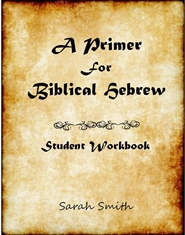A Primer for Biblical Hebrew was written for parents to introduce the Hebrew alphabet (Aleph Bet) and beginning vocabulary to children from ages seven to ten. The course consists of a teacher’s manual and a student workbook. You are given permission to reproduce pages in the student workbook for your household.
Author Sarah Smith says that she waits until a child has had two years of phonics before beginning A Primer for Biblical Hebrew, and I second that recommendation. A child might easily get confused trying to learn the basics of phonics, reading, and writing in English at the same time that a foreign language with a totally different structure is introduced. There’s no need to rush into this, so wait until children are ready.
The teacher’s manual is essential. Three introductory sections provide critical information and cannot be skipped. Parents should spend time familiarizing themselves with this material before they begin to teach. The first of these sections explains how the course is to be taught and has a pronunciation guide for the English transliterations that are included within the lessons. The second section has a chart showing the Hebrew consonants, their names, their pronunciations, and diagrams showing how to form each letter. A separate chart shows how vowels are formed, their names, their English transliterations, and their sounds. The third section explains how to read Hebrew—that it is read from right to left, that vowels are formed by putting marks beneath or above consonants, that words are “decoded” one syllable at a time, and other critical information.
There are a number of different activities in the consumable student workbook. There are lines for students to trace and practice letter formation just as we find in beginning handwriting programs for English. There are coloring pages, generally three per lesson. These pages illustrate words that begin with letters being taught in each lesson, so they serve as lesson reinforcements to some extent. Coloring page illustrations look like a mixture of pages from coloring books for Bible stories and coloring books for children from fifty years ago. Older children might balk at the coloring, so skip it if that’s the case. Pages of flashcards for vocabulary and for Hebrew letters are at the back of the student workbook. (I would copy, print, or paste these onto card stock for durability.) You need to go to the publisher’s website for instructions for games using these cards.
Student workbooks also have other exercises, puzzles, and activities. Many of the exercises have students read Hebrew syllables aloud as they practice identifying written sounds. In the last quarter of the course, some exercises have children transliterate Hebrew syllables into English words or syllables, with the results reading like entire English sentences—this is practice in reading Hebrew syllables rather than translating them. Parents might need to assist children quite a bit with those exercises. While children learn to read some words, the emphasis throughout the program is on learning the complex vowel and consonant combinations of the Hebrew language along with commonly-used biblical vocabulary.
I have not studied Hebrew myself, and I find it challenging to grasp and apply all of these unfamiliar concepts simultaneously. It’s much more difficult than learning a language that uses essentially the same alphabet as we do in English. I expect many children will feel the same, so allow plenty of time for them to absorb the material and understand it before moving ahead. Explanations in the teacher’s manual are sufficient for the parent who doesn’t already know Hebrew to be able to teach a child, although there are nuances skipped over in this primer that might leave the parent unsure about how to teach or answer questions.
While the course can be completed in a year, you might spread it out over a few years as long as you continually review and practice what has already been learned.
The coloring pages, images, and some of the exercises make A Primer for Biblical Hebrew most suitable for children in the primary grades, but the course can also be used by older students and adults who want to learn Hebrew.








